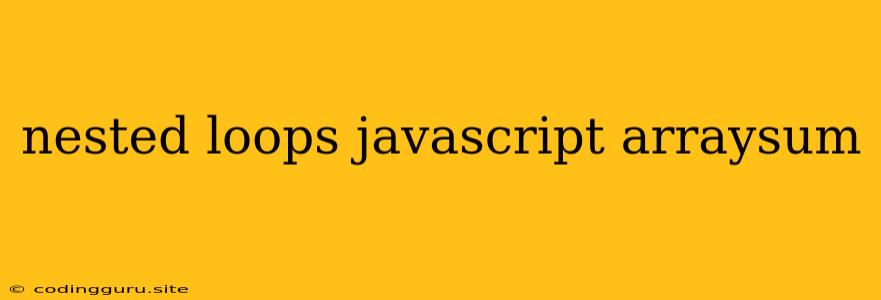Nested Loops in JavaScript: Exploring the Power of Iteration for Array Summation
Nested loops are a powerful tool in JavaScript programming, especially when dealing with multi-dimensional data structures like arrays. They enable us to iterate through each element within an array, providing the flexibility to perform complex operations on nested data. One common application is calculating the sum of all elements within an array.
Understanding Nested Loops
Nested loops are essentially loops within loops. The outer loop iterates through the primary array, while the inner loop iterates through each element of the current array element if it is also an array. This structure allows us to access and manipulate nested data effectively.
How to Implement Nested Loops for Array Summation
Let's break down how to use nested loops to calculate the sum of all elements in a nested JavaScript array:
1. Defining the Array:
First, we need to define the array that we'll be working with. This array can contain any number of nested arrays. Here's an example:
const nestedArray = [
[1, 2, 3],
[4, 5, 6],
[7, 8, 9]
];
2. Initializing the Sum:
We'll use a variable to store the running sum as we iterate through the array. Start by setting it to 0:
let sum = 0;
3. The Outer Loop:
The outer loop will iterate through each element of the main array (in our example, the array nestedArray):
for (let i = 0; i < nestedArray.length; i++) {
// ...
}
4. The Inner Loop:
Inside the outer loop, the inner loop will iterate through each element of the current sub-array (each element of the main array is an array itself):
for (let i = 0; i < nestedArray.length; i++) {
for (let j = 0; j < nestedArray[i].length; j++) {
// ...
}
}
5. Summation:
Within the inner loop, we access the current element and add it to the sum variable:
for (let i = 0; i < nestedArray.length; i++) {
for (let j = 0; j < nestedArray[i].length; j++) {
sum += nestedArray[i][j];
}
}
6. Displaying the Result:
Finally, we can print the calculated sum:
console.log("The sum of all elements is:", sum);
Complete Code:
const nestedArray = [
[1, 2, 3],
[4, 5, 6],
[7, 8, 9]
];
let sum = 0;
for (let i = 0; i < nestedArray.length; i++) {
for (let j = 0; j < nestedArray[i].length; j++) {
sum += nestedArray[i][j];
}
}
console.log("The sum of all elements is:", sum);
Example and Visualization
Imagine nestedArray as a grid:
[ [1, 2, 3],
[4, 5, 6],
[7, 8, 9] ]
The outer loop (using variable i) goes through each row:
- Row 1:
[1, 2, 3] - Row 2:
[4, 5, 6] - Row 3:
[7, 8, 9]
The inner loop (using variable j) goes through each element within the current row:
- Row 1:
1,2,3 - Row 2:
4,5,6 - Row 3:
7,8,9
The nested loop structure allows us to systematically traverse each cell (each element) within this grid, accumulating the sum along the way.
Additional Considerations
- Handling Arrays with Different Lengths: If your nested array has sub-arrays with varying lengths, you'll need to adjust the inner loop's condition to ensure it doesn't go beyond the boundaries of the current sub-array.
- Alternative Methods: While nested loops are effective, alternative approaches like using the
reduce()method with a nestedforEach()loop can achieve the same outcome and often provide more concise code. - Error Handling: It's crucial to consider scenarios where the input array might be undefined or have invalid data. Implement checks to handle these situations gracefully.
Conclusion
Nested loops are a fundamental concept in JavaScript programming, enabling us to iterate through multi-dimensional data structures effectively. By understanding how they work, we can utilize their power to perform complex operations on arrays, like calculating the sum of all elements in a nested array. While nested loops are a versatile tool, it's important to explore alternative methods like reduce() and forEach() for potentially more efficient and cleaner code, especially for complex array manipulations.
